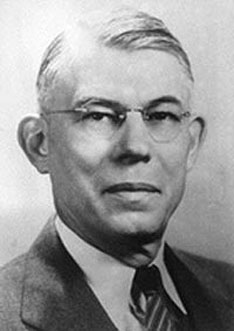Edward Adelbert Doisy
Edward Adelbert Doisy (November 13, 1893 – October 23, 1986) was an American biochemist who shared the Nobel Prize in Physiology or Medicine in 1943 with Henrik Dam for their discovery of vitamin K and its chemical structure. Doisy's work not only contributed to the understanding of the role of vitamins in human health but also paved the way for the development of anticoagulant therapies, which have saved countless lives.
Early Life and Education[edit | edit source]
Edward Adelbert Doisy was born in Hume, Illinois, USA. He pursued his higher education at the University of Illinois, where he received his Bachelor of Arts in 1914 and his Master of Arts in chemistry in 1916. He then went on to earn his Ph.D. in biochemistry from Harvard University in 1920.
Career and Research[edit | edit source]
After completing his education, Doisy began his academic career at Washington University in St. Louis, where he would spend a significant portion of his professional life. It was here that he conducted his groundbreaking research on hormones and vitamins, particularly vitamin K.
Doisy's research initially focused on the isolation and characterization of estrogen, making significant contributions to the understanding of female reproductive hormones. However, his most notable work came from his studies on vitamin K, a fat-soluble vitamin that plays a crucial role in blood clotting.
In the early 1930s, Henrik Dam, a Danish biochemist, discovered that chicks fed a diet deficient in a certain fat-soluble factor developed hemorrhages and bleeding disorders. This factor was later identified as vitamin K. Building on Dam's work, Doisy and his team were able to isolate vitamin K, determine its chemical structure, and synthesize it, achievements that led to their Nobel Prize win.
Nobel Prize[edit | edit source]
In 1943, Edward Adelbert Doisy and Henrik Dam were jointly awarded the Nobel Prize in Physiology or Medicine "for their discovery of vitamin K and its chemical structure." This recognition highlighted the importance of vitamins in nutrition and disease prevention, as well as the role of scientific research in advancing medical knowledge.
Later Years and Legacy[edit | edit source]
After his Nobel Prize win, Doisy continued his research and teaching at Saint Louis University, where he had moved in 1923. He remained active in the scientific community until his retirement. Over his career, Doisy published numerous papers and was a member of several prestigious scientific organizations.
Edward Adelbert Doisy passed away on October 23, 1986, leaving behind a legacy of scientific achievement that has had a lasting impact on medicine and nutrition. His work on vitamin K not only advanced our understanding of vitamins but also led to the development of anticoagulant drugs, which are crucial in the treatment of blood clotting disorders.
See Also[edit | edit source]
Translate: - East Asian
中文,
日本,
한국어,
South Asian
हिन्दी,
தமிழ்,
తెలుగు,
Urdu,
ಕನ್ನಡ,
Southeast Asian
Indonesian,
Vietnamese,
Thai,
မြန်မာဘာသာ,
বাংলা
European
español,
Deutsch,
français,
Greek,
português do Brasil,
polski,
română,
русский,
Nederlands,
norsk,
svenska,
suomi,
Italian
Middle Eastern & African
عربى,
Turkish,
Persian,
Hebrew,
Afrikaans,
isiZulu,
Kiswahili,
Other
Bulgarian,
Hungarian,
Czech,
Swedish,
മലയാളം,
मराठी,
ਪੰਜਾਬੀ,
ગુજરાતી,
Portuguese,
Ukrainian
Navigation: Wellness - Encyclopedia - Health topics - Disease Index - Drugs - World Directory - Gray's Anatomy - Keto diet - Recipes
Search WikiMD
Ad.Tired of being Overweight? Try W8MD's physician weight loss program.
Semaglutide (Ozempic / Wegovy and Tirzepatide (Mounjaro / Zepbound) available.
Advertise on WikiMD
WikiMD is not a substitute for professional medical advice. See full disclaimer.
Credits:Most images are courtesy of Wikimedia commons, and templates Wikipedia, licensed under CC BY SA or similar.Contributors: Prab R. Tumpati, MD

